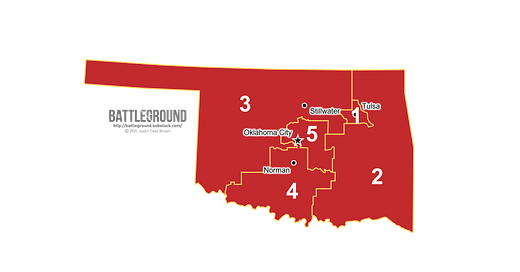Oklahoma: Republicans "Deport" Hispanics via Gerrymandering
Republicans may have disenfranchised the state's fastest growing minority group.
Topline Takeaways
Changes to Oklahoma’s congressional districte almost exclusively confined to the state’s cities.
Oklahoma County (home to Oklahoma City) had almost the exact number of residents to be its own congressional district. Instead, Republicans cracked the city’s population across 3 different districts
The new districts may violate the Voting Rights Act as the new boundaries separate more than half of Oklahoma City’s Hispanic population away from the rest of the city, diluting their vote as they’re thrown into a heavily White OK-3.
Who Is In Control?
Oklahoma’s redistricting process is completely controlled by the state legislature and requires gubernatorial approval before being adopted. Republicans are firmly in the driver’s seat here as they hold a trifecta: majorities in both houses alongside a Republican governor.
New District Breakdown
Oklahoma county (home to Oklahoma City) recorded 796,000 residents in the 2020 census and the ideal district size for the state’s new congressional districts is about 792,000 residents. This makes Oklahoma county an almost perfect candidate to be its own congressional district as it only needs to shed 4,000 residents to hit the ideal size. Instead, Republican mapmakers grouped the county with portions of six surrounding rural counties while the central area of the city is split between 3 districts.
Redrawing the urban OK-5 in this fashion takes a moderately competitive district (originally tilting only 5 points toward Republicans) and makes it decidedly more safe for Republicans (new boundaries would have seen Trump win here by 18 points). While the partisan implications of these maps are clearly in favor of Republicans, the changes made likely run afoul of the Voting Rights Act due to the way the new districts disproportionately impact the city’s growing Hispanic population.
Moved South of the Border
The 2020 census found that Oklahoma’s Hispanic population grew more than any other demographic group over the past 10 years, increasing by 42% since 2010. Much of this growth has been concentrated just south of Oklahoma City in neighborhoods that have become majority Hispanic over time. Despite this growing influence, mapmakers drew boundaries around the most heavily Hispanic areas in the city, cutting them out of OK-5 and instead threw them into a primarily rural OK-3 that stretches into the state’s panhandle. This cuts the number of Hispanics in OK-5 in half, reducing their representation down to barely 10% within the district. Meanwhile, Hispanic voters moved into OK-3 are now heavily outnumbered by White rural voters living hundreds of miles away. This unquestionably dilutes the power of the Hispanic vote and locals have taken notice. (There are no oustanding legal challenges as of yet.)
“It sends a message to our constituents: ‘It doesn’t matter what you think as long as we’re in charge.’” -State Rep. Jose Cruz (D)
“You know for a fact that somebody had to look at that and say, ‘Hey, there’s too many Hispanics in this particular area and if we don’t divide it, they’re gonna have a larger voice if they come together.’” -State Sen. George Young (D)





